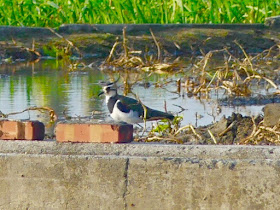
I had 1 day off to settle my water account matter with AirSelangor and was busy shopping for groceries when I saw messages from my Sarawak friend about a lost wild bird. Her friend had found a wild snipe species in her house in Shah Alam. With some time to spare in the afternoon, I volunteered to drop by her house in Bukit Rimau, Shah Alam to assist. Elian (Julianna's friend) found the bird, dazed with feathers scattered all over her room early in the morning. It was caught by one of her cats, survived that encounter and Elian placed it safely in a cage (for her pet dog) away from her two dogs and cat. She had fed it some water and when I reached her house from KL, the snipe was frozen still inside the cage. It was still spooked and was trying to wriggle itself free when I held it for a few seconds to look for any injuries. It had a slightly swollen left eye. Other than that, it looked healthy and had pooped a bit in the cage. I held it for a second time whilst transferring it into a 1.5 ft x 1.5 ft box, whilst Elian hugged her cat, keeping it at a safe distance away from the snipe. We covered the top of box with a piece of matting giving the snipe enough breathing space. I could hear it moving about in box whilst I was driving from Bukit Rimau Residential area to Shah Alam Botanical Gardens, which had a patch of paddyfields (for educational/recreational purpose). Driving to the nearest agricultural paddyfields would take more than 1 hour. That was a long journey in a box for a snipe which was not worth the risk.

The Snipe was spreading its wings and looked restless inside the box. I placed the box on the ground in an area with tallest grasses at the Botanical Gardens, with paddyfield behind and a big pond nearby. The Snipe walked straight into the grasses and disappeared in a matter of minutes. After checking with friends and looking through Craig Robson's Field Guide to the Birds of Southeast Asia (2000 edition), the rescued Snipe was a male Greater Painted Snipe. Wetlands such as paddyfields are its usual habitat. Greater Painted Snipe (male) with its chick were seen walking in the paddyfields of Batang Tiga, Malacca during a 2016 trip which you can read HERE. A short video of the Greater Painted Snipe below (before it was released). It was an unexpected and incidental bird for me that afternoon. May Mother Nature extend its life for a long time to come, until it reaches its final (paddyfield? or other wetlands?) destination.





 The Orangutan came down from the tree, lured by the ripened bananas laid out on the wooden platform by the Park Wardens.
The Orangutan came down from the tree, lured by the ripened bananas laid out on the wooden platform by the Park Wardens.  The orangutan started to stuff as many bananas as it could in its mouth, as demonstrated by the pictures below:) With a mouthful of bananas, it started to climb back up to tree to enjoy its meal in private far from the prying eyes of us humans who were delighted to have seen it in its (almost) natural environment.
The orangutan started to stuff as many bananas as it could in its mouth, as demonstrated by the pictures below:) With a mouthful of bananas, it started to climb back up to tree to enjoy its meal in private far from the prying eyes of us humans who were delighted to have seen it in its (almost) natural environment. 
 This Centre serves as a sanctuary
for rescued orangutans which are trained on how to fend for themselves before
they are released to into the forest. Fascinating to learn that the Orangutans share
almost 97% of the same DNA as us, humans. Unfortunately whilst human beings have
the United Nations Conventions to protect the rights of minorities such as
women and children, the orangutans rely on human beings to ensure their right
to live in forests without being captured as pets.
This Centre serves as a sanctuary
for rescued orangutans which are trained on how to fend for themselves before
they are released to into the forest. Fascinating to learn that the Orangutans share
almost 97% of the same DNA as us, humans. Unfortunately whilst human beings have
the United Nations Conventions to protect the rights of minorities such as
women and children, the orangutans rely on human beings to ensure their right
to live in forests without being captured as pets.


















































